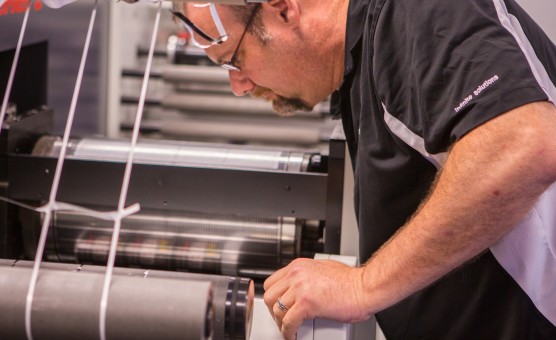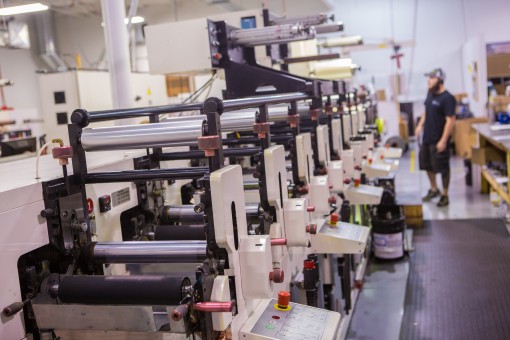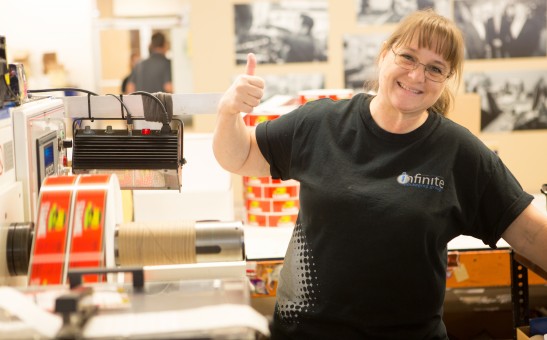
Most package printers and converters are specialists, honing finely tuned skills to meet and exceed the demands of brand owners who expect perfection. But there are a few companies that see opportunity in offering a more complete range of packaging and converting services and building deep relationships with brand owners and customers.
One such company is TLMI member Infinite Packaging, with operations in Dallas, Texas and Tulsa, Oklahoma. The company operates under the belief that labels and packaging bring a brand to life and that making customers successful will make it successful. With that in mind, the company relies on a fleet of flexo presses in both locations and an HP Indigo 6600, providing labels, flexible packaging, and folding cartons to customers ranging from small businesses to national brand names.
The Tulsa plant is all-flexo-all-the-time, its shop floor primarily populated with Nilpeter presses, while Dallas features five Nilpeter flexo machines, two running eight colors and three with 10-color capabilities, plus the HP Indigo 6600 label press, which Principal and COO Gary Dunlap (above, left) says is the first Indigo in Texas used exclusively for packaging applications.
Bringing a Brand to Life
A broad range of industries served and a focus on developing relationships with customers has driven Infinite Packaging to offer a full-range of capabilities that satisfy the needs of each market segment. Brand owners invariably want more than packaging that’s merely printed to their specifications—they seek a partner on whom they can depend and who will provide continuous support.
“Our culture at Infinite Packaging is built around telling our customers ‘Yes,’ ’’explains Principal & CEO Lynn Higgs (above right). “Our ability to provide a broad spectrum of products and services is key to delivering it,” .
“We educate our clients on the benefits of flexo and digital technologies and direct our assets to meet their specific needs,” continues Higgs, “Our success always begins with understanding our clients’ business and bringing their brands to life.”
Executing this goal are a variety of products and services, spanning design, R&D, prototypes, production excellence, inventory programs, and on-site personnel, all designed to assist in streamlining and improving the process.
Building client relationships is a key part of Infinite’s business strategy and the company makes a point of striving to understand customers’ brands and their needs in the marketplace. Infinite takes pride in what it produces, adding value to the process, has ownership in the various brands, and can even offer its own perspective on how a brand’s packaging should look. Savvy brand owners expect this and many have come to rely on Infinite for complete packaging support for multiple products.
Click here for more on the history of Infinite Packaging.
To achieve this, Infinite has configured its presses to help deliver on customer expectations. Other than the number of ink stations, most of the Nilpeters in both locations are similarly configured, replete with lamination, screen printing, corona treatments, and more. “A lot of converters have one top-end press,” relates Dunlap. “But almost all of ours are fully outfitted so we can easily move jobs around and not have delays while waiting for a press with certain features to become available.”
According to Dunlap, having multiple 10-color presses also has a way of eliminating some of the competition, especially when it comes to producing shrink sleeves. “Some competitors can’t offer that many colors, and when you get into that level of job, we are known for delivering the quality certain clients require.”
Clients appreciate the inline finishing capabilities of the Nilpeter presses, relying on them for screen printing, raised varnishes (i.e., doming or tactile), foiling, and more.
Dunlap also likes the productivity. “When you can do everything in a single run, the flexo press is just more productive,” he says. “It has real advantages for high-end decoration on cosmetics and nutraceuticals.” In contrast, the digital press at Infinite uses a two-step process with finishing done separately on an ABG Digicon.
The Mixed Platform Advantage
With the range of jobs typically in process at Infinite, the range of substrates the Nilpeters and HP Indigo can accommodate provides a significant advantage. “Customers come to us for high-end, top quality labels,” says Dunlap. “Being able to run the jobs on either platform provides a great advantage, especially when there are multiple SKUs or when short runs are required. Our primary business is labels, shrink sleeves and pouches and we do all of those on both platforms. We also do some pouches on the HP along with prototypes and other short-run jobs.”
Dunlap says having both digital and flexo presses adds capabilities and lets the company better service a full spectrum of client needs. “Digital may not be a huge share of our business but what it does for our clients is priceless in many ways,” he says.
For instance, having shelf presence is critical for brand owners and is mission critical for smaller companies trying to gain traction with a big retailer. Smaller-size Infinite Packaging customers have used the Indigo to provide a more professional look and feel when showing new products to a big retailer. In one notable example, a customer had 14 new products it hoped to place in the aisles of one of America’s largest big box retailers. The customer needed to show real packages, not sample mock-ups, but understandably didn’t want to pay for 14 sets of six flexographic color plates to create a handful of samples. So Infinite ran all the samples on the Indigo and the
client went to the retailer. “They got the contract,” recounts Dunlap. “And the resulting order was, of course, huge, so we ran all those jobs flexo. But it wouldn’t have happened if we didn’t have the digital capability.”
Color Critical
Of course, the risky part in such a process is ensuring the colors are consistent from one press technology to another—and brand owners are acutely aware of color. To keep this critical element under control, Infinite uses Esko’s HD Flexo process to ensure colors are accurate on any of its flexo presses and has fingerprinted the HP Indigo to match the flexo machines. This also adds value on a day-to-day basis, explains Dunlap. “Depending on run length and print windows, many SKUs could be run on either type of press, so we need colors to be consistent across all our machines,” he says. “Colors must match and we do all we can to do that proactively, which makes it easier for us and better for our customers.”
Infinite is hardly the only converter to have flexo and digital presses on the shop floor and even running the same jobs. Yet company management did not come
easily to the digital decision. “We’d been watching digital printing in packaging for some years,” relates Dunlap. “A competitor had even tried it in their shop and decided it wasn’t for them. We were trying to increase the level of quality we could offer, but at the same time were getting bogged down with the increased number of short runs. The obvious thing was to offload some of the work being done on the flexo presses, but we still needed to deliver the quality our customers looked for. We finally decided we had to make the move.”
Operating economics
As it turned out, having the Indigo came to be a clear differentiator. “It showed customers we were trying to improve and service them better,” says Dunlap. “And it has made us more nimble, especially as the number of SKUs has grown. It makes you crazy when you’re trying to use a 13˝ or 16˝ 10-color flexo press to do short turns.”
He notes that it is “easy to look at the basic economics and think you can get two or three flexo presses for the price of a single digital press, but it really comes down to deciding which press best lets you service your customers.” When they did the math, Dunlap and his partners realized how much time job changeovers required on very short-run jobs, plus the costs of plates and waste. With the volume of work normally in process, the labor savings alone began to justify the investment in a digital press.
“So it’s like I need a rifle and I need a handgun,” continues Dunlap in pure Texan form. “I wanted to get runs with high SKU counts out of my flexo production. Digital is under 10 percent of total sales, but has helped us transform our business by being more responsive.”
In broad terms, jobs of 5,000 feet or more wind up on a flexo press, but production schedules also relate to client needs and turnaround times. Those factors sometimes mean longer run jobs go on the digital press simply because it may have better availability, or because a job involves multiple plate changes. And finally, while color is generally easier to manage on a digital press, jobs needing a good shot of solid white or pastel colors can be better candidates for a flexo press.
The Relationship Business
With incoming work spanning multiple types of packaging, Infinite Packaging has found that the package, no matter how it is printed and produced, is only the end product of an ongoing and continually nurtured relationship with brand owners.
“If a customer has complexity in their package production, such as a high SKU count, an inventory problem, many different products requiring a mix of labels, shrink, pouches, and so on., we can help them,” affirms Dunlap. “In some cases we have our own employee on-site at customer, which is a big value add.”
“We try to be embedded at every facet of a customer’s life, because very few of our customers need or buy only one thing from us. We’re not in the packaging business, we are in the relationship business.”













